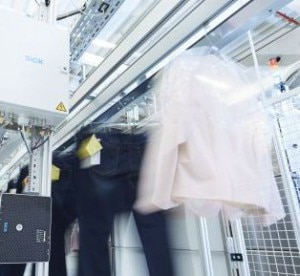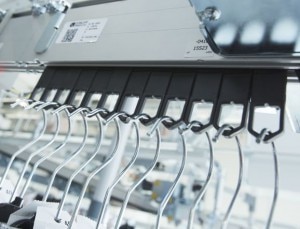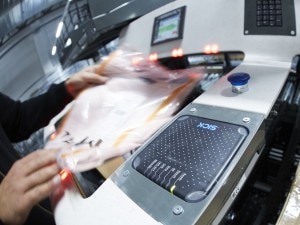An increasing number of digital solutions are also being used in the fashion and clothing industries. The opportunities range from labeling products and presentations in stores all the way through to interaction with the online shop. As announced as part of its current reorientation strategy (known as FIT- 4GROWTH), the GERRY WEBER group will be placing more focus on the issue of digitalization in future and making the most of the potential in omni-channel retail.

The company has already established an important basis for this process by investing in a new logistics center and modifying its logistics processes. The new logistics center in Ravenna Park in Halle, Westphalia, has been in the ramp-up phase since December 2015. This center is where GERRY WEBER will control all of its own logistics processes in future. With the launch of the new logistics center, the previously decentralized logistics structures will be optimized and bundled at a single site. Currently being stored in separate warehouses and at the companys logistics partners during the transition period, hanging garments and flatpacked goods will be brought together in the new logistics center in a step-by-step process.

The accelerated value chain for the world of fast fashion and the dynamic changes resulting from increased digitalization require high-quality data and seamless data transparency throughout the entire value chain. GERRY WEBER first launched a project for optimizing its entire international value chain back in 2009. As part of this project, RFID was employed for optimizing logistics workflows and retail processes, as well as being used as a new form of goods security. During this development process, the company came up with another innovative idea: The normal care label was enhanced to create a textile RFID label that combined the security function, the manufacturers care notes, and an electronic product code. This code is now even due to get married in the new logistics center.
The right products in the right place
GERRY WEBER uses RFID systems by SICK for fully automated picking and identifying items of clothing. The RFID gate system RF-GOH for hanging garments and the RFID tunnel system RFMS Pro were designed in conjunction with the conveyor system manufacturer and integrated into the new GERRY WEBER logistics center. Further manual picking stations are also equipped with RFID technology by SICK.
Hanging products: marrying the transponders in the adapter link-in station
Sensitive clothing that you would normally hang up at home is stored on hangers and picked from there. This helps to avoid a possible drop in quality while at the same time ensuring that the customers receive a ready-to-wear piece of clothing when they buy it in store or get it delivered straight to their door.

To achieve fully-automated returns processing and order picking for hanging products that keeps order throughput times as short as possible and picking accuracy as high as possible, the new GERRY WEBER logistics center is equipped with two solutions that work well together: one UHF transponder on the care label in the item of clothing and one HF transponder in the roller adapter, which is used to hang the hanger up with the piece of clothing. Every item is fitted with an RFID tag at the goods entry point. The care label and RFID tag are not always stitched into the same place in every item of clothing. In light of this, a length of around 1.80 m has to be scanned in order to evaluate the first source. This takes place using the SICK gate, explains Jürgen Dietsch, the Director Logistics Systems at GERRY WEBER International AG. The other source is a small adapter which runs along the top in the roller adapter with a unique identification number. The challenge here is to allocate the transponder in the clothing to the HF transponder in the adapter so that the marriage can take place. We can now read this data and merge it together - consolidating HF (high frequency) and UHF (ultra high frequency). By consolidating information about the item of clothing with the ID number, the process can then be automated and generally improved across the board. Otherwise, we would have to install one of these tunnel gates at every point where a decision has to be made. This then comes down to costs and space.
The RF-GOH gate track and trace system
The RF-GOH system was developed specifically for RFID identification on hanging conveyor systems. The intelligent allocation algorithm allows several RFID tags to be read at the same time and also calculates the position of each RFID tag. This creates a unique link between the RFID tag and the hanging product - even for objects that are close together on the conveying line. Furthermore, the system detects and filters the static transponders in the surrounding area. Based on SICKs 4Dpro concept, bar code scanners and read devices can also be integrated into the system. For example, this allows the information in the UHF transponder in the item of clothing to be linked to the information in the HF transponder on the hanger. The same is true of merging the UHF data with the bar code data. The modular MSC800 system controller forms the heart of the system. The hardware built into the controller and its integrated allocation algorithm generates a particularly high level of reliability. The MSC800 makes any relevant data from all of the integrated sensors available to the control system.
The tunnel: The RFMS Pro track and trace system can even read hand-written notes

Items such as sweaters, shirts, or accessories are folded up for delivery. Any boxes full of folded items are tracked completely using the RFMS Pro track and trace system by SICK. Because the transponders can be read reliably in the tunnel gate, any items packed tightly inside a shipping carton can be recorded. With the RFMS Pro track and trace system, SICK combines tried-and-tested components and sensors used in a wide array of other solutions to form an innovative end-to-end solution: The 4Dpro from SICK integrates the RFMS Pro easily into any application - even in combination with other technologies for automatic identification (a laser scanner or camera, for example). In addition, a solution to measure the volume can be integrated to output the dimensions of the particular object. The advantage: All required data are output via one unit and one Interface. The outstanding image quality of the built-in image-based ICR89x code reader also makes it suitable for use in OCR and video coding applications. Besides RFID read/write devices, the tunnel is also equipped with an OCR camera for reading plain text on labels, such as handwritten information regarding quantity or other item attributes in the event of returns, says Jürgen Dietsch, describing the requirements.

Pick-and-pack systems are used to send folded items to the stores or warehouses. GERRY WEBER uses UHF RFID RFU62x read/write devices from SICK for this purpose. Their well-defined, restricted read/write range is particularly well-suited for automatic identification over small object distances. In this case, the scanned product is placed directly in the outgoing box. A pick-to-light indication makes sure the item is allocated to the right box. Finally, one last scan verifies that the box contains what it is supposed to. The new GERRY WEBER logistics center is currently in the ramp-up phase and capacity will be increased in a step-bystep process. At the moment, even more additional functions are being brought in to make the individual logistics processes even better. The logistics center is expected to start working at full capacity in 2016 and will turn over up to 30 million items per year. Capacity can also be increased to 37 million items a year if necessary.
Example for an RFID application:
- Product portfolio: RFID Solutions from SICK
- More information: Gerry Weber

